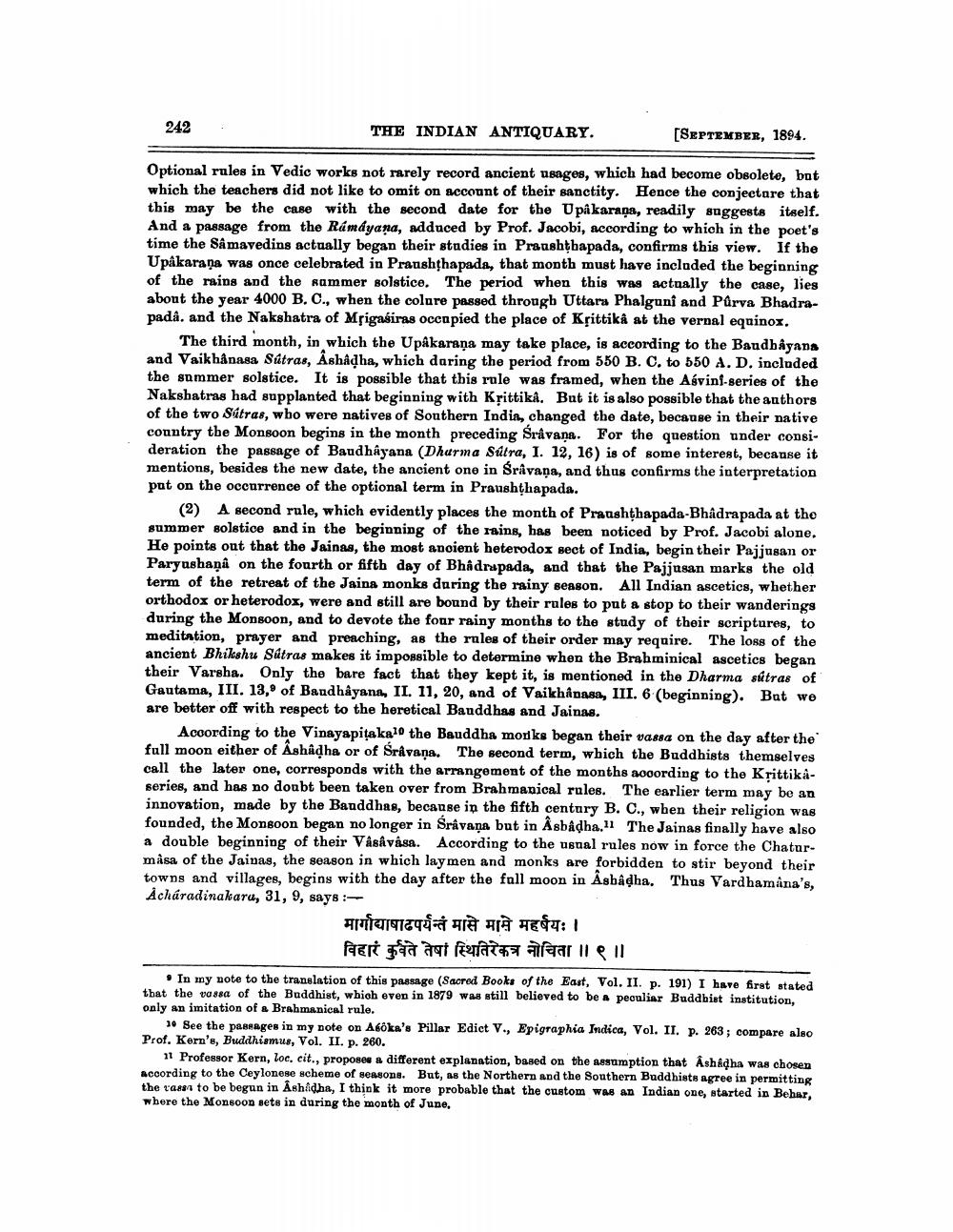________________
242
THE INDIAN ANTIQUARY.
[SEPTEMBER, 1894.
Optional rules in Vedic works not rarely record ancient usages, which had become obsolete, bat which the teachers did not like to omit on account of their sanctity. Hence the conjecture that this may be the case with the second date for the Upakarana, readily suggests itself. And a passage from the Rámáyana, adduced by Prof. Jacobi, according to which in the poet's time the Så mavedins actually began their studies in Praushthapada, confirms this view. If the Upakarana was once celebrated in Pranshthapada, that month must have included the beginning of the rains and the rammer solstice. The period when this was actually the case, lies about the year 4000 B. C., when the colure passed through Uttara Phalguni and Parva Bhadrapada, and the Nakshatra of Mrigasiras occupied the place of Ksittik at the vernal equinox,
The third month, in which the Upåkaraṇa may take place, is according to the Baudbâyans and Vaikhanasa Sátras, Ashadha, which daring the period from 550 B. C. to 550 A. D. included the summer solstice. It is possible that this role was framed, when the Asvini-series of the Nakshatras had supplanted that beginning with Krittika. But it is also possible that the authors of the two Sátras, who were natives of Southern India, changed the date, because in their native country the Monsoon begins in the month preceding Sravana. For the question under consideration the passage of Baudhayana (Dharma Sútra, I. 12, 16) is of some interest, because it mentions, besides the new date, the ancient one in Sråvaņa, and thus confirms the interpretation put on the occurrence of the optional term in Praushthapada.
(2) A second rule, which evidently places the month of Praushthapada-Bhadrapada at the summer solstice and in the beginning of the rains, has been noticed by Prof. Jacobi alone. He points out that the Jainas, the most ancient heterodox sect of India, begin their Pajjusan or Paryushan on the fourth or fifth day of Bhadrapada, and that the Pajjusan marks the old term of the retreat of the Jaina monks during the rainy season. All Indian ascetics, whether orthodox or heterodox, were and still are bound by their rules to put a stop to their wanderings during the Monsoon, and to devote the four rainy months to the study of their scriptures, to meditation, prayer and preaching, as the rules of their order may require. The loss of the ancient Bhikshu Sátras makes it impossible to determine when the Brahminical ascetics began their Varsha. Only the bare fact that they kept it, is mentioned in the Dharma stras of Gautama, III. 13, of Baudhayana, II. 11, 20, and of Vaikhanasa, III. 6 (beginning). But we are better off with respect to the heretical Bauddhas and Jainas.
According to the Vinayapita kało the Bauddha monks began their vassa on the day after the full moon either of Ashâdha or of Srävana. The second term, which the Buddhists themselves call the later one, corresponds with the arrangement of the months according to the Krittikaseries, and has no doubt been taken over from Brahmanical rules. The earlier term may be an innovation, made by the Bauddhas, because in the fifth century B. C., when their religion was founded, the Monsoon began no longer in Sråvaņa but in Asbadha,11 The Jainas finally have also a double beginning of their Vâsâvâsa. According to the usual rules now in force the Chaturmasa of the Jainas, the season in which lay men and monks are forbidden to stir beyond their towns and villages, begins with the day after the full moon in Asbadha. Thus Vardhamana's, Acháradinakaru, 31, 9, says :
मार्गाद्याषाढपर्यन्तं मासे मामे महर्षयः । विहारं कुर्वते तेषां स्थितिरेकत्र नोचिता ॥९॥
. In my note to the translation of this passage (Sacred Books of the East, Vol. II. p. 191) I have first stated that the tossa of the Buddhist, which even in 1879 was still believed to be a peculiar Buddbist institution, only an imitation of a Brahmanical rule.
30 See the passages in my note on Abiks's Pillar Edict V., Epigraphia Indica, Vol. II, p. 263; compare also Prof. Kern's, Buddhismus, Vol. II. p. 260.
11 Professor Kern, loc. cit., propose a different explanation, based on the assumption that Ashkąha was chosen according to the Ceylonese scheme of seasons. But, as the Northern and the Southern Buddhists agree in permitting the rasan to be begun in AshAdha, I think it more probable that the custom was an Indian one, started in Behar, where the Monsoon sets in during the month of June,




